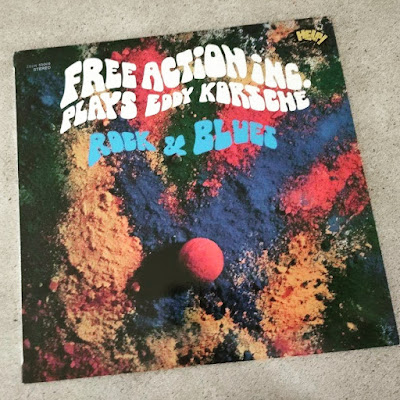Αναρτήσεις
Προβολή αναρτήσεων από 2020
Bala Miller And The Great Music Pirameeds Of Afrika - Pyramids 1979 (Afrodisia)
- Λήψη συνδέσμου
- X
- Ηλεκτρονικό ταχυδρομείο
- Άλλες εφαρμογές
LISZTOMANIA 2020
- Λήψη συνδέσμου
- X
- Ηλεκτρονικό ταχυδρομείο
- Άλλες εφαρμογές
Bappi Lahiri - Maut Ka Saya 1981 (His Master's Voice)
- Λήψη συνδέσμου
- X
- Ηλεκτρονικό ταχυδρομείο
- Άλλες εφαρμογές
Harlem Pop Trotters - Harlem Pop Trotters 1975 (Les Tréteaux)
- Λήψη συνδέσμου
- X
- Ηλεκτρονικό ταχυδρομείο
- Άλλες εφαρμογές
Free Action Inc. Plays Eddy Korsche – Rock & Blues 1970 (Help!)
- Λήψη συνδέσμου
- X
- Ηλεκτρονικό ταχυδρομείο
- Άλλες εφαρμογές
Various - Quel Organ ! 2008 (Disques Georges Profünd)
- Λήψη συνδέσμου
- X
- Ηλεκτρονικό ταχυδρομείο
- Άλλες εφαρμογές
Descendants Of Mike & Phoebe - A Spirit Speaks 1974 (Strata-East)
- Λήψη συνδέσμου
- X
- Ηλεκτρονικό ταχυδρομείο
- Άλλες εφαρμογές
Pekka Pohjola - Harakka Bialoipokku 1974 (Love Records)
- Λήψη συνδέσμου
- X
- Ηλεκτρονικό ταχυδρομείο
- Άλλες εφαρμογές
Barbara Keith - Barbara Keith 1973 (Reprise Records)
- Λήψη συνδέσμου
- X
- Ηλεκτρονικό ταχυδρομείο
- Άλλες εφαρμογές
Braen, Raskovich – Afro Beat / Afro Flower 2018 (Four Flies Records)
- Λήψη συνδέσμου
- X
- Ηλεκτρονικό ταχυδρομείο
- Άλλες εφαρμογές
Larry T. And The Family – I'm Moving On 1980 (LET Music)
- Λήψη συνδέσμου
- X
- Ηλεκτρονικό ταχυδρομείο
- Άλλες εφαρμογές
A. Hawkshaw & B. Bennett - Synthesizer And Percussion 1974 (Themes International Music)
- Λήψη συνδέσμου
- X
- Ηλεκτρονικό ταχυδρομείο
- Άλλες εφαρμογές
Brother Jack McDuff - Moon Rappin' 1969 (Blue Note)
- Λήψη συνδέσμου
- X
- Ηλεκτρονικό ταχυδρομείο
- Άλλες εφαρμογές
Tony Allen – A Tribute To Art Blakey And The Jazz Messengers 2017 (Blue Note)
- Λήψη συνδέσμου
- X
- Ηλεκτρονικό ταχυδρομείο
- Άλλες εφαρμογές
Martial Solal - Locomotion 1974 (PSI)
- Λήψη συνδέσμου
- X
- Ηλεκτρονικό ταχυδρομείο
- Άλλες εφαρμογές
David Axelrod - Songs Of Experience 1969 (Capitol)
- Λήψη συνδέσμου
- X
- Ηλεκτρονικό ταχυδρομείο
- Άλλες εφαρμογές
Berkely Ike Jones - Nation Building 1979 (Skylark Records)
- Λήψη συνδέσμου
- X
- Ηλεκτρονικό ταχυδρομείο
- Άλλες εφαρμογές
Rhythm Of The Rain compiled by Electric Looser
- Λήψη συνδέσμου
- X
- Ηλεκτρονικό ταχυδρομείο
- Άλλες εφαρμογές
Sandro Brugnolini - Superground 2019 (Four Flies Records)
- Λήψη συνδέσμου
- X
- Ηλεκτρονικό ταχυδρομείο
- Άλλες εφαρμογές
Mary Afi Usuah – African Woman 1978 (Clover Sound)
- Λήψη συνδέσμου
- X
- Ηλεκτρονικό ταχυδρομείο
- Άλλες εφαρμογές
Krzysztof Sadowski - Krzysztof Sadowski And His Hammond Organ 1970 (Polskie Nagrania Muza)
- Λήψη συνδέσμου
- X
- Ηλεκτρονικό ταχυδρομείο
- Άλλες εφαρμογές
Free Orbit – Free Jazz Goes Underground 1970 (MPS)
- Λήψη συνδέσμου
- X
- Ηλεκτρονικό ταχυδρομείο
- Άλλες εφαρμογές
Suspiria Dario Argento 1977
- Λήψη συνδέσμου
- X
- Ηλεκτρονικό ταχυδρομείο
- Άλλες εφαρμογές
Pieces Of A Dream – Warm Weather 1981 (Electra)
- Λήψη συνδέσμου
- X
- Ηλεκτρονικό ταχυδρομείο
- Άλλες εφαρμογές
Alfonso Carlos Santisteban - Bossa '68 1968 (Sintonia)
- Λήψη συνδέσμου
- X
- Ηλεκτρονικό ταχυδρομείο
- Άλλες εφαρμογές
Joy Unlimited – Overground 1970 (Polydor)
- Λήψη συνδέσμου
- X
- Ηλεκτρονικό ταχυδρομείο
- Άλλες εφαρμογές
Oby Onyioha - I Want To Feel Your Love 1981 (Time)
- Λήψη συνδέσμου
- X
- Ηλεκτρονικό ταχυδρομείο
- Άλλες εφαρμογές
Murphy Williams – She Is My Woman 1981 (Taretone)
- Λήψη συνδέσμου
- X
- Ηλεκτρονικό ταχυδρομείο
- Άλλες εφαρμογές
Marco Di Marco Trio - At The Living Room 1973 (Modern Jazz Records)
- Λήψη συνδέσμου
- X
- Ηλεκτρονικό ταχυδρομείο
- Άλλες εφαρμογές
Black Children Sledge Funk Co. Band – Vol. 3 - Aviation Grand Father 1979 (RTS)
- Λήψη συνδέσμου
- X
- Ηλεκτρονικό ταχυδρομείο
- Άλλες εφαρμογές
Various - Formation 60 (modern jazz from eastern germany Amiga 1957-69) 1998 (Jazzanova Compost Records)
- Λήψη συνδέσμου
- X
- Ηλεκτρονικό ταχυδρομείο
- Άλλες εφαρμογές
The Jeremy Spencer Band - Flee 1979 (Atlantic)
- Λήψη συνδέσμου
- X
- Ηλεκτρονικό ταχυδρομείο
- Άλλες εφαρμογές
Twylyte '81 – The First Coming 1981 (JSR)
- Λήψη συνδέσμου
- X
- Ηλεκτρονικό ταχυδρομείο
- Άλλες εφαρμογές

































